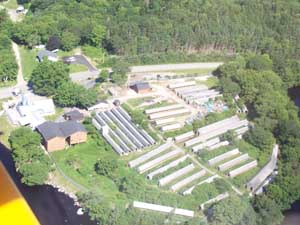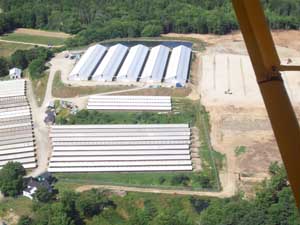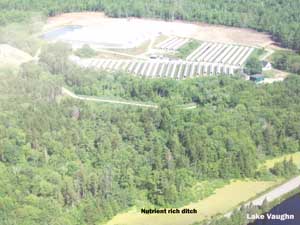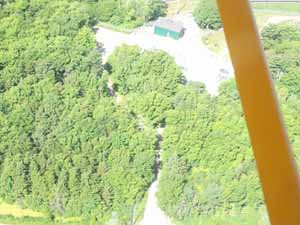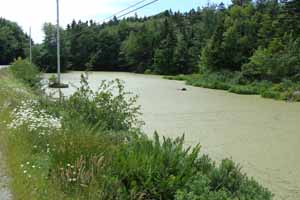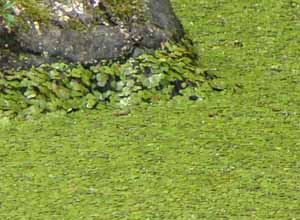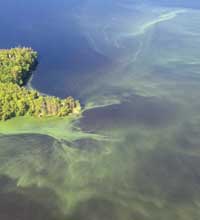 Raynardton is a
small area, nestled in between the communities of Deerfield
and Tusket Falls . It is attractively set around Lake
Vaughan, the roads circling the lake on both sides. Lake
Vaughan is a man-made lake, created over 100 years ago by
the first settlers. It is now used as a source of
electricity for the Nova Scotia Power Company. Swimming is
very popular in the summer time, and the lake attracts
wildlife such as loons, ducks, beavers, muskrats, and a
fairly large fish supply. The area is very beautiful all
year round. In the fall the trees are lit up with colors,
and in winter it becomes a winter wonderland. The area is
also attractive for homes. Many people, young and old, have
found the area a good place to raise a family, spend a quiet
retirement or expand family roots. Many people have been
moving into the area, building new homes or renovating old
ones. Aside from new settlers, there are many who are
ancestors of the first settlers. The names "Raynard" and
"Andrews" still live on, being the most dominant families.
There is a sense of family and history in this small
community.
Raynardton is a
small area, nestled in between the communities of Deerfield
and Tusket Falls . It is attractively set around Lake
Vaughan, the roads circling the lake on both sides. Lake
Vaughan is a man-made lake, created over 100 years ago by
the first settlers. It is now used as a source of
electricity for the Nova Scotia Power Company. Swimming is
very popular in the summer time, and the lake attracts
wildlife such as loons, ducks, beavers, muskrats, and a
fairly large fish supply. The area is very beautiful all
year round. In the fall the trees are lit up with colors,
and in winter it becomes a winter wonderland. The area is
also attractive for homes. Many people, young and old, have
found the area a good place to raise a family, spend a quiet
retirement or expand family roots. Many people have been
moving into the area, building new homes or renovating old
ones. Aside from new settlers, there are many who are
ancestors of the first settlers. The names "Raynard" and
"Andrews" still live on, being the most dominant families.
There is a sense of family and history in this small
community.JOB RAYNARD The first settler to put down roots and start a community here was Job Raynard. He was born in England in 1763, and was a soldier in the War of Independence in New York. After the war he, and many other settlers, settled in Shelburne before coming to what is now Raynardton around 1791.
More information http://www.yarmouth.org/villages/raynardt/index.htm
Picture taken by Allister d'Entremont over the northern end of Lake Vaughan June 22,2011.
From: John Horton <halleyhort@hotmail.com>
To: john horton <halleyhort@hotmail.com>
Subject: Woods Mink Farm, Lake Vaughan.July 2011Woods Mink Farm ,located on Lake Vaughan in
Gavelton, Yarmouth county,NS.
Up the hill ,the unseen part of Woods farm shows lots of new construction , excavation and expansion. Nutrients flow readily through a canopy of trees and vegetation towards the lake , creating a tangled mess of "fertilized" water plants and Cyanobacteria in roadside ditches and ponds.
Do concerned residents have any power to stop this ? You might be surprised at the plans and commitments that have een made by our Department of Agriculture. ...........It ain't good for our waterways!
Duckweed
is not an algae it is not toxic
and can be used as an animal
feed. It is an indication of
excess nutrients in the water.
Up the hill ,the unseen part of Woods farm shows lots of new construction , excavation and expansion. Nutrients flow readily through a canopy of trees and vegetation towards the lake , creating a tangled mess of "fertilized" water plants and Cyanobacteria in roadside ditches and ponds.
Do concerned residents have any power to stop this ? You might be surprised at the plans and commitments that have een made by our Department of Agriculture. ...........It ain't good for our waterways!
Will settling ponds and cat nine
tails solve the problem of "nutrient
loading" in Lake Vaughan? Hardly.
The
only practical way to deal with
water-soluble nutrients is
to prevent them from reaching our
waterways in the first place.
John
Halley Horton
Forest Glen
| Raynardton: Lake Vaughan 2013 | ||
|
Ditch on
Raynardton road near wood mink
farm. Note: bright green area
in aerial picture above
Julia Bancroft |
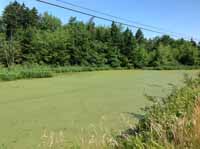 |
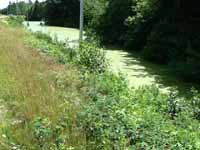 |
